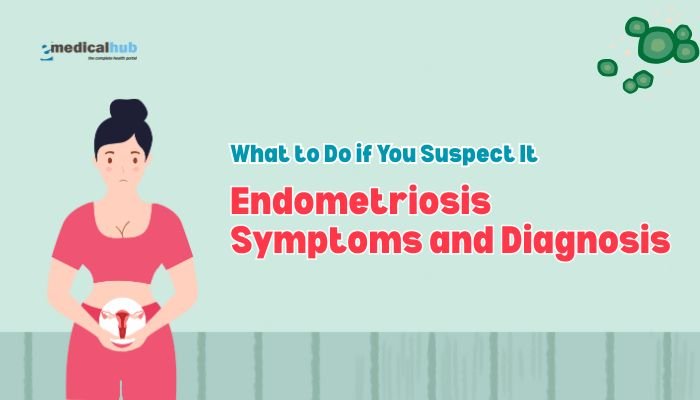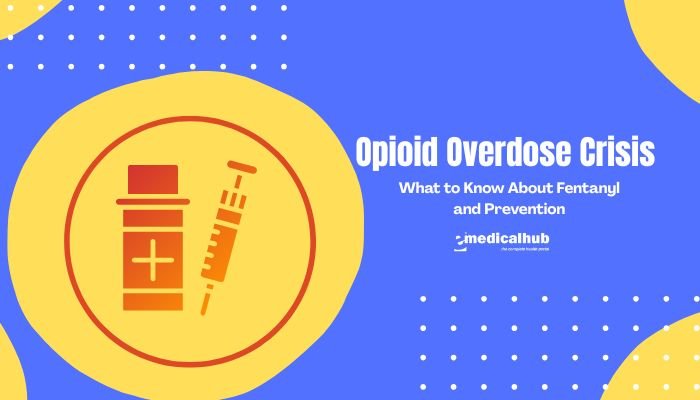Introduction
Endometriosis is a condition in which tissue resembling the lining of the uterus (endometrium) grows outside of its normal location. This tissue may appear on organs in the pelvic area (e.g., ovaries, fallopian tubes, outer uterine walls) or on tissues lining the pelvis. Less commonly, it shows up in other areas of the body.
This out-of-place endometrial tissue can thicken and bleed during the menstrual cycle, much like the uterine lining does. However, because the misplaced tissue has nowhere to exit, it can irritate surrounding structures and trigger inflammation or scar tissue. This often leads to ongoing pain and other symptoms, especially around menstruation.
Many people with endometriosis struggle for years before receiving a diagnosis. Early recognition and proper evaluation can bring relief and reduce the risk of complications. This article discusses possible endometriosis symptoms, how the condition is diagnosed, and steps to consider if you suspect you have it.
What Is Endometriosis?
Endometriosis is thought to affect up to 10% of reproductive-aged individuals. It can develop in teenagers and adults of childbearing age, although it sometimes persists after menopause. It is less common in postmenopausal women but can still occur.
Basic Concept
- Uterine Lining (Endometrium): During the menstrual cycle, this lining thickens in preparation for a possible pregnancy. If fertilization does not happen, the lining sheds as menstrual flow.
- Endometriosis Tissues Elsewhere: In endometriosis, cells resembling the endometrium grow outside the uterus. They can follow monthly hormonal cues, thickening and bleeding with each cycle, causing inflammation if the blood and tissue accumulate in or around pelvic organs.
Where Endometriosis Might Appear
- Ovaries: Tissue on or within the ovaries can form cysts (“endometriomas”).
- Fallopian Tubes: Endometriosis near or on tubes can interfere with their function, raising fertility concerns.
- Pelvic Peritoneum: The lining inside the pelvic cavity is a common site.
- Uterine Ligaments: Tissue sometimes appears on supporting structures of the uterus, leading to pelvic pain or painful intercourse.
- Bowel or Bladder: Some have endometriosis on the intestines or urinary structures, possibly causing digestive or urinary symptoms around menstruation.
- Rare Sites: In a few cases, endometriosis may spread beyond the pelvis (e.g., chest cavity, surgical scars).
Quote: “Endometriosis involves tissue similar to the uterine lining growing where it does not belong, fueling chronic pain and other concerns.”
Recognizing Possible Symptoms
Symptoms vary widely. Some individuals have severe pain, whereas others experience mild discomfort or none at all. Not all pelvic pain is endometriosis, but certain patterns point to the condition.
Common Signs
- Painful Periods (Dysmenorrhea): Cramping can be more intense and longer-lasting than typical menstrual pain. Some describe stabbing or throbbing sensations in the lower abdomen, lower back, or pelvic region.
- Chronic Pelvic Pain: Persistent pain not limited to the menstrual cycle. This can disrupt daily activities and sometimes worsens around ovulation or before a period starts.
- Painful Intercourse: The presence of endometrial-like tissue near the uterus or pelvic ligaments can make sex uncomfortable or painful (dyspareunia).
- Excessive Bleeding: Some with endometriosis experience heavier-than-usual menstrual flow or spotting between periods.
- Bowel or Bladder Symptoms: Painful bowel movements or urination, sometimes more noticeable around menstruation, may be a clue. Diarrhea, constipation, bloating, or blood in the stool during periods can also occur.
- Fatigue: Chronic pain and hormonal fluctuations often lead to tiredness, especially if pain interferes with normal sleep.
Less Common or Subtle Symptoms
- Lower Back or Leg Pain: Tissue on pelvic nerves might cause pain that radiates beyond the pelvis.
- Shoulder Pain: Rarely, endometrial-like tissue appears in areas such as the diaphragm, potentially referring pain to the shoulder region.
- Fertility Challenges: Although not every person with endometriosis struggles with conceiving, some experience difficulty.
Impact on Daily Life
Individuals with endometriosis often report an overall decreased quality of life due to pain or other physical and emotional stressors. Work or school performance may suffer, and relationships or self-image can be affected by chronic pelvic pain or fertility concerns.
Key Tip: If painful periods are so severe that normal routines become difficult, endometriosis is one possibility to consider.
Possible Reasons for Delayed Diagnosis
Endometriosis sometimes remains undetected for years. Studies indicate it can take 7–10 years on average from the onset of symptoms to a confirmed diagnosis. Multiple factors contribute to these delays:
- Normalization of Menstrual Pain: Many people are told that period pain is “just part of being a woman,” causing them to dismiss severe symptoms.
- Varied Symptom Profiles: Not everyone experiences hallmark signs like extremely painful periods. Some might have only mild or atypical complaints.
- Lack of Awareness: Patients and healthcare providers might not initially suspect endometriosis if symptoms are subtle or overlap with other conditions (e.g., irritable bowel syndrome).
- Limited Access to Specialist Care: Gynecologists or specialized practitioners familiar with endometriosis are crucial. In areas where specialty care is scarce, diagnosis can take longer.
Quote: “Endometriosis can hide behind normal assumptions about menstrual pain, leading to misdiagnosis or delayed treatment.”
How Endometriosis Is Diagnosed
Although there is no single, definitive blood test, medical professionals use various approaches to diagnose or strongly suspect endometriosis:
Clinical History and Exam
- Symptom Discussion: A doctor typically asks about menstrual cycles, pain duration, location, and severity. Details about pain during sex, bowel movements, or urination are important.
- Pelvic Exam: By feeling the uterus, ovaries, and other pelvic structures, a doctor might detect cysts or nodules. However, smaller lesions are not always palpable, so a normal exam does not rule out endometriosis.
Imaging
- Transvaginal Ultrasound (TVUS): A probe inserted into the vagina produces images of the uterus and ovaries. Large endometriomas (ovarian cysts) can be seen. However, smaller implants may be missed.
- MRI (Magnetic Resonance Imaging): Gives a more detailed view of pelvic anatomy and is sometimes used for suspected deep infiltrating endometriosis.
Laparoscopy
- Definitive Diagnosis: A minimally invasive surgical procedure where a small camera is inserted through an incision near the navel to visualize the pelvic organs.
- Biopsy: During laparoscopy, suspicious lesions can be sampled or removed. Laboratory analysis confirms endometriosis if endometrial-like cells are detected.
- Therapeutic Benefits: Surgeons may remove or ablate visible lesions, potentially offering symptom relief while confirming the diagnosis.
Other Investigations
- Hormone Levels: Not routinely used for diagnosis, though doctors might check other hormones (like thyroid or prolactin) to exclude different conditions.
- CA-125 Blood Test: Elevated in some with advanced endometriosis, but not specific enough for diagnosis.
Key Tip: Although a laparoscopic exam is considered the gold standard for diagnosis, doctors often make a provisional diagnosis based on symptoms and imaging. Surgical confirmation may be reserved for complex cases or those needing definitive therapy.
What to Do if You Suspect Endometriosis
If you experience symptoms raising suspicion for endometriosis, the following steps can guide you toward proper diagnosis and care:
Track Symptoms
- Symptom Diary: Note when pain starts, how intense it is (on a scale of 1–10), and which activities make it worse or better.
- Menstrual Cycle Details: Track cycle length, heaviness of flow, presence of spotting.
- Associated Symptoms: Bowel changes, urinary changes, or pelvic pain during intercourse.
- Pain Patterns: Does pain peak before or during periods? Or is it also present at mid-cycle?
A symptom diary can give a doctor clear evidence and patterns, helping differentiate endometriosis from other conditions.
Seek Medical Evaluation
- Primary Care Visit: Begin by sharing concerns with a primary care physician or general practitioner.
- Referrals: If symptoms or exam findings suggest endometriosis, the doctor may refer you to a gynecologist who has experience with pelvic pain.
- Second Opinions: Endometriosis is complex. If initial advice feels incomplete or your concerns remain, consult a specialist or consider a second opinion.
Discuss All Symptoms
- Be Detailed: Mention even non-gynecologic symptoms, such as bowel discomfort or lower back pain that worsens with menstruation.
- Ask Directly: Inquire if endometriosis might be a possibility, especially if you suspect it or have a family history.
Diagnostic Imaging
- Request Ultrasound: If severe or persistent symptoms exist, an ultrasound can provide preliminary information.
- MRI Consideration: For unclear cases or suspected deep involvement, an MRI can offer a detailed map of possible lesion sites.
Talk About Treatment Trials
Sometimes, doctors may propose a trial of hormonal treatment (e.g., birth control pills) to see if symptoms improve. This can strengthen the suspicion of endometriosis, though it does not confirm the diagnosis as conclusively as laparoscopy.
Possible Treatment Approaches
Endometriosis treatment aims to relieve symptoms, slow lesion growth, and preserve or improve fertility if desired. Exact strategies vary based on severity, patient goals, and the extent of lesions.
Pain Management
- NSAIDs: Over-the-counter anti-inflammatory drugs (e.g., ibuprofen) can ease cramps and pelvic pain.
- Heating Pads: Local heat soothes muscle tension and can be used alongside medication.
- Physical Therapy: Pelvic-floor therapy sometimes helps alleviate deep pelvic pain.
Hormonal Therapies
- Birth Control Pills: Combined estrogen-progestin pills may reduce menstrual flow and pain.
- Progestin-Only Methods: Intrauterine devices (IUDs) or progestin injections can curb the menstrual cycle, diminishing pain and lesion progression.
- GnRH Agonists or Antagonists: These suppress ovarian hormone production, putting the body in a temporary low-estrogen “menopausal” state. Doctors often limit duration due to side effects.
Surgical Intervention
- Laparoscopic Surgery: Surgeons remove or burn endometriotic lesions and scar tissue, often relieving pain and potentially improving fertility outcomes.
- Hysterectomy: As a last resort for those with severe endometriosis, removing the uterus (and sometimes the ovaries) can eliminate some pain triggers. This is irreversible and typically only considered if other methods fail or childbearing is no longer a goal.
Lifestyle Modifications
- Diet: Some find an anti-inflammatory diet (e.g., rich in vegetables, fruits, whole grains, and omega-3 fatty acids) beneficial for pain control.
- Exercise: Moderate exercise can help reduce chronic pain, improve mood, and support general health.
- Stress Management: Yoga, meditation, or counseling can assist with coping, since chronic pain often affects mental well-being.
Key Tip: Endometriosis management is tailored to individual goals—whether it’s pain relief, fertility, or both. Keep an open dialogue with healthcare providers to adjust treatment plans as needed.
Lifestyle and Self-Care Strategies
Living with endometriosis can be challenging, but certain self-care measures may help manage daily pain and stress.
Diet and Nutrition
- Anti-Inflammatory Choices: Vegetables, legumes, berries, fish.
- Limit Processed Foods: High sugar or refined carbohydrates can worsen inflammation in some.
- Stay Hydrated: Adequate water intake supports overall health.
- Consider Supplements: Omega-3 fatty acids or vitamin D may be recommended, but consult a healthcare provider for guidance.
Physical Activity
- Gentle Exercises: Walking, swimming, yoga, or Pilates can maintain flexibility and circulation without placing too much strain on the pelvis.
- Pelvic Floor Therapy: A specialized physical therapist can show exercises to relax and strengthen the pelvic floor muscles, which might be tense from chronic pain.
Stress Reduction
- Relaxation Techniques: Deep breathing, progressive muscle relaxation, or guided imagery to calm the nervous system.
- Pacing: Spreading activities throughout the day, balancing rest and movement to avoid flare-ups.
- Journaling: Writing down thoughts or feelings about pain can reduce emotional load and track triggers.
Support Networks
- Counseling or Therapy: Chronic pain can contribute to anxiety, depression, or relationship strains. Mental health support is beneficial.
- Online or In-Person Groups: Sharing experiences with others who understand endometriosis fosters a sense of community and learning.
Fertility Considerations
Endometriosis can sometimes reduce fertility by distorting pelvic anatomy or causing inflammation. However, many individuals with endometriosis still conceive naturally or with medical assistance.
Discuss Family Plans Early
- Fertility Counseling: If pregnancy is a future goal, speak with a specialist. They can consider how endometriosis might affect timing or treatment.
- Surgical Intervention: Removing endometriotic lesions may improve pregnancy chances for some patients, though results vary.
- Assisted Reproduction: Options like in vitro fertilization (IVF) can help if natural conception proves difficult.
Emotions Around Fertility
Fertility struggles can cause stress or sadness. Counseling and partner communication are helpful for coping with these concerns.
Myths and Facts about Endometriosis
- Myth: Only people with very painful periods have endometriosis.
Fact: Some have mild or atypical symptoms, or no major pain. Pain intensity alone does not confirm or exclude endometriosis. - Myth: Endometriosis always causes infertility.
Fact: It can impair fertility, but many conceive naturally or with guidance. Severity and lesion location influence outcomes. - Myth: Hysterectomy is a complete cure for endometriosis.
Fact: Even after hysterectomy (especially if the ovaries remain), endometriosis lesions elsewhere can still cause symptoms. It is not always a permanent fix. - Myth: Pregnancy cures endometriosis.
Fact: Some experience symptom relief during pregnancy due to hormonal changes, but symptoms often return postpartum. It is not a guaranteed “cure.” - Myth: If you have endometriosis, pain must be excruciating.
Fact: Pain levels vary. Some with advanced disease have mild aches, whereas others with minimal disease have severe pain.
Emotional and Mental Health Aspects
Chronic pelvic pain disrupts daily life, relationships, and self-image. Patients often feel isolated or misunderstood, especially if diagnosis was delayed. Addressing mental well-being is crucial for holistic care.
Coping with Chronic Pain
- Cognitive Behavioral Therapy (CBT): Can reduce pain perception, offering new ways to handle distress.
- Mind-Body Techniques: Meditation or biofeedback fosters relaxation and may help calm pain signals.
- Realistic Goals: Celebrate small improvements in pain or daily function, avoiding the trap of perfection.
Communication
- Open Dialogue: Share your experiences with loved ones so they understand the condition is not “just period pain.”
- Workplace Disclosures: Some choose to inform employers or colleagues to explain occasional absences or the need for flexible hours.
Setting Boundaries
Pacing activities, politely declining overcommitment, or delegating tasks can protect energy levels and minimize pain flare-ups.
Questions to Ask Healthcare Providers
If you suspect endometriosis, consider bringing a list of questions to your next medical appointment:
- Could endometriosis explain my symptoms?
- What steps will we take to confirm the diagnosis?
- Which treatments or lifestyle changes do you recommend first?
- How might this condition affect my fertility plans?
- What can I do daily to manage pain at home?
- When should I consider seeing a specialist (e.g., a reproductive endocrinologist or pain specialist)?
- Severe Pain Crises: Extremely intense pelvic or abdominal pain that impairs normal functioning.
- Signs of Infection: Fever, foul-smelling discharge, or sudden worsening after a procedure or surgery.
- Acute Bleeding or Anemia Symptoms: Very heavy periods can lead to significant fatigue, dizziness, or shortness of breath.
- Bowel or Bladder Obstruction Symptoms: Difficulty passing stool or urine, blood in stool or urine, or severe abdominal swelling.
Key Tip: Endometriosis rarely causes life-threatening emergencies, but severe or abrupt changes should prompt immediate medical evaluation.
Table: Common Diagnostic and Treatment Pathways
| Step | Method | Benefit | Limitation |
| Initial Screening | Symptom discussion, pelvic exam | Identifies possible red flags | Not definitive for smaller lesions |
| Imaging | Ultrasound, MRI | Visual check for cysts or deep lesions | Might miss small or superficial implants |
| Laparoscopy | Surgical camera exam, biopsy | Gold standard for confirmation | Invasive; not always first-line for mild cases |
| Medication | Hormonal treatments (pill, IUD, GnRH) | Reduces symptoms, slows lesion growth | May not eliminate all pain, side effects exist |
| Surgical Removal | Laparoscopic excision/ablation | Directly removes lesions, can relieve pain | Risk of recurrence, potential surgical risks |
| Lifestyle Measures | Diet, exercise, stress management | Complements medical therapies, reduces pain | Not always sufficient alone for advanced disease |
Summary of Key Points
- Monitor Your Body: Note pain patterns, menstrual cycle irregularities, and other symptoms.
- Consult Early: Severe or persistent period pain is not automatically “normal.” Seek professional assessment.
- Diagnostic Path: Pelvic exams, imaging, and sometimes laparoscopy help confirm endometriosis.
- Individualized Treatment: Options include medication, surgery, or combining multiple strategies based on severity and fertility goals.
- Lifestyle Support: A balanced diet, gentle exercise, and stress reduction can enhance pain relief.
- Advocate for Yourself: Delays are common. If your symptoms are dismissed, consider finding a specialist who is familiar with endometriosis.
FAQs (Frequently Asked Questions)
- Can young teenagers have endometriosis?
Yes. It can start soon after the onset of menstruation. Severe period pain in adolescence warrants checking for endometriosis. - Does birth control fix endometriosis?
It can help manage symptoms by reducing menstrual flow and suppressing hormones that encourage lesion growth. However, it is not a permanent cure. - Can endometriosis disappear on its own?
In some cases, symptoms improve after menopause due to lower hormone levels, but it does not necessarily vanish completely. Some remain symptomatic or have flare-ups even post-menopause. - Is there a special endometriosis diet?
No single official diet is universally recommended. However, many benefit from an anti-inflammatory eating plan high in vegetables, lean protein, and healthy fats. - What if I want to get pregnant?
Consult a fertility specialist early. Surgery to remove lesions, or assisted reproductive technologies, can sometimes boost fertility rates. - Is laparoscopic surgery always required?
Not always for mild suspected cases. Some respond well to medication. But surgery is the only definitive way to diagnose and remove lesions. - How can I best reduce daily pain?
A mix of pain relievers (like NSAIDs), heat therapy, gentle exercise, and stress management helps many. Ask a doctor about prescription options or advanced therapies if needed
Conclusion
Endometriosis involves tissue resembling the uterine lining growing in the wrong places, leading to chronic pain, heavy or irregular periods, and potential fertility challenges. Timely recognition of symptoms—like severe period pain, painful intercourse, or bowel and bladder discomfort during menstruation—can prompt earlier evaluation. Diagnosis usually begins with a thorough symptom review, pelvic exam, and imaging, with laparoscopy providing definitive confirmation.
Treatment depends on each person’s severity, life goals, and overall health. Hormonal therapies and surgery offer relief for many, while supportive measures such as exercise, dietary adjustments, and stress reduction further improve quality of life. Because endometriosis can vary widely in presentation, individuals should track symptoms carefully, communicate openly with healthcare providers, and consider second opinions if faced with uncertainty or lack of improvement.
Remember that you know your body best. If you suspect endometriosis, do not hesitate to seek specialized care. By addressing the condition head-on—through a blend of medical options, lifestyle changes, and emotional support—you can better manage pain and preserve reproductive health for years to come.
References
- Giudice LC, Kao LC. Endometriosis. Lancet. 2004;364(9447):1789-1799.
- Kennedy S, Koninckx P, D’Hooghe T, et al. ESHRE guideline for the diagnosis and treatment of endometriosis. Hum Reprod. 2005;20(10):2698-2704.
- Vercellini P, Vigano P, Somigliana E, et al. Endometriosis: pathogenesis and treatment. Nat Rev Endocrinol. 2014;10(5):261-275.
- Shafrir AL, Farland LV, Shah DK, et al. Infertility and the risk of endometriosis—A population-based study. Fertil Steril. 2018;109(1):119-126.
- Nnoaham KE, Hummelshoj L, Webster P, et al. Impact of endometriosis on quality of life and work productivity: a multicenter study across 10 countries. Fertil Steril. 2011;96(2):366-373.
- Burney RO, Giudice LC. Pathogenesis and pathophysiology of endometriosis. Fertil Steril. 2012;98(3):511-519.
- Zondervan KT, Becker CM, Koga K, et al. Endometriosis. Nat Rev Dis Primers. 2018;4:9.
- Dunselman GA, Vermeulen N, Becker C, et al. ESHRE guideline: Management of women with endometriosis. Hum Reprod. 2014;29(3):400-412.
- Saraswat L, Ayansina D, Cooper KG, et al. Pregnancy outcomes in women with endometriosis: a national record linkage study. BJOG. 2017;124(3):444-452.
- Falcone T, Flyckt R. Clinical management of endometriosis. Obstet Gynecol. 2018;131(3):557-571.
- Rogers PA, Adamson GD, Al-Jefout M, et al. Research priorities for endometriosis. Reprod Sci. 2017;24(2):202-226.
- Moradi M, Parker M, Sneddon A, et al. Impact of endometriosis on women’s lives: a qualitative study. BMC Womens Health. 2014;14:123.




